[Note: Investing on the secondary market at Lending Club is often riskier and more speculative than the primary market. It exists as a sort of Wild West in p2p lending. Despite this, many Folio-only investors go on to have positive experiences.]
Many people get excited about peer to peer lending, but when they try to open an account, they find their state is closed to investors. Large states like Texas fall into this category. Thankfully, if you are someone who lives in a closed state, there is still one option you can explore.
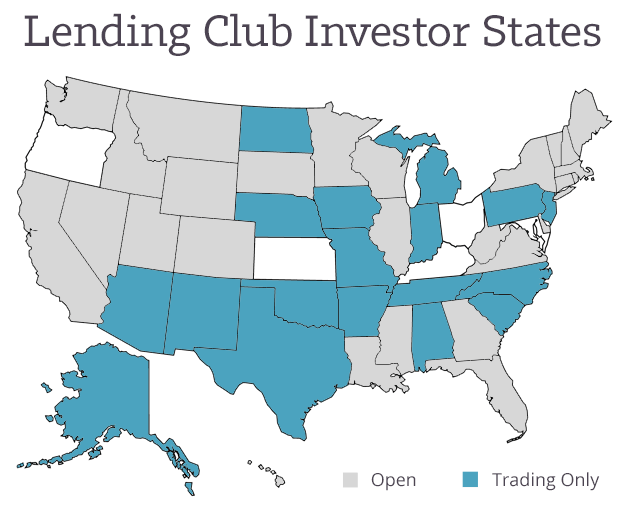
That option is to open a trading account at Lending Club through Folio. At the time of this article,17 of the 22 states closed to Lending Club still allow trading (see states in blue above). While it may be a bit more complicated, the trading platform remains an equally valid way to earn a great return in peer to peer lending.
Folio is where the buying and selling of already-issued loans takes place.
What is the Folio secondary market? Peer to peer loans have been classified as securities by the SEC, which means they can be bought and sold. Folio is where this buying and selling of already-issued loans takes place. In this article, I will break down the basic steps of how to invest a lump sum on Folio.
In this example, we’ll use the typical minimum investment of $5,000 (you can start with less if you want, explained later).
Step #1: Open an account at Lending Club
The process for opening a trading account is quick and painless. To do so, click here and fill out the simple form. Opening the account is completely free, secure via SSL-encryption, and takes just a few minutes.
Note: investors in Kansas, Oregon, Maryland, or Ohio cannot open an account.
Step #2: Transfer money into your account
You’ll need to connect your bank by providing your account and routing numbers. Lending Club will then verify your bank by making a few trial deposits (less than $1). By typing the value of these deposits into their website, you prove the account is yours. You can now transfer money to Lending Club by clicking on the Transfer link in the navigation:
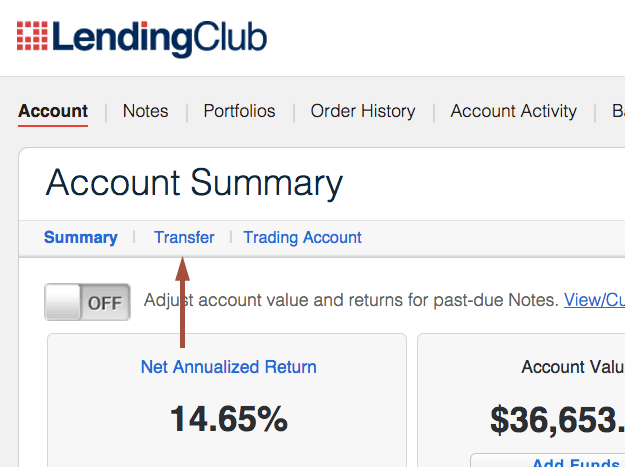
How much money should you invest?
The answer to this question is different for everybody. If you are brand new to Lending Club, you’ll probably want to start with the minimum. What is the minimum? You want to spread your cash across 200+ loans, and since the minimum loan portion (a ‘note’) is $25, this means you should probably start with at least $5,000 (200 X $25 = $5000).
Once you’ve been earning great returns for some time, you could increase it into a more substantial portion of your overall portfolio. Almost all investors start small and scale from there as they become more comfortable.
Step #3: Review the Loan Grades (Risk Strategy)
Once your account is open and fully funded, you will need to decide how much risk to take on. You do this by choosing what loan grades you want to invest in. Lending Club has seven loan grades from A to G, with A-grade loans being the safest and G-grade loans being the riskiest.
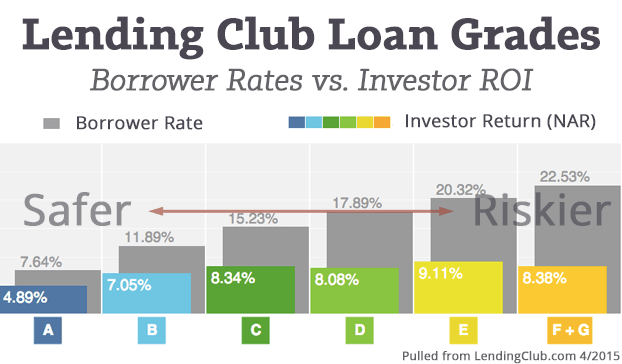
Safer loan grades like A and B-grades have lower interest rates, so they give a lower return to investors. However, they are much more stable overall, particularly in an economic downturn where the unemployment rate increases and borrowers start defaulting on their loans. On the other hand, riskier grades (C-G) are more volatile, but they have historically had much higher yields (see my returns).
Most investors choose to spread their cash across a mix of different loan grades, though everybody’s situation is different. Read: What Loan Grades Should I Choose?
Step #4: Spread your Investment Across 200+ Notes (Diversify)
Alright! Now that your account is funded with $5000 and you’ve decided what grades you want, it’s time to actually invest in some loans. To do this, navigate over to the trading platform by clicking on the Trading Account link in the navigation:
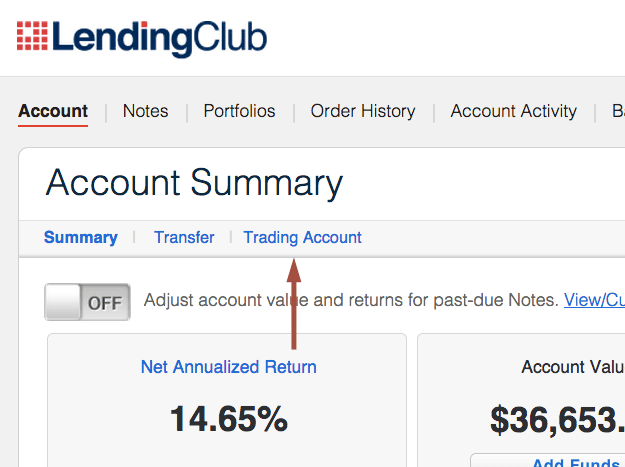
Clicking on this link will take you to Folio. Once here, you can (and should) read Lending Club’s descriptions of secondary market buying and selling through the Welcome and How It Works links in the navigation. To invest your $5,000 lump sum, click the Browse Notes link at the top. You should see this:
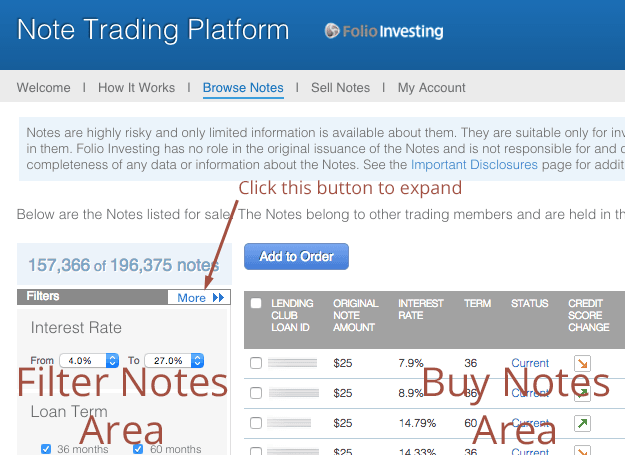
As seen above, Lending Club currently has over 196,000 notes available for investment. Looking through this list is too much work, so we will shrink it down by using the filter-notes area on the left. Once the list is filtered and smaller, we will purchase notes using the buy-notes area on the right.
Click on the “More >>” link to expand the filter area to its full width. Here is where things get a little complicated. People invest on Folio in all sorts of ways (notes with long positive histories, late notes, etc). Today we will try and imitate the primary market experience by finding notes that are both newer and healthy. To do this, use these six filtering criteria:
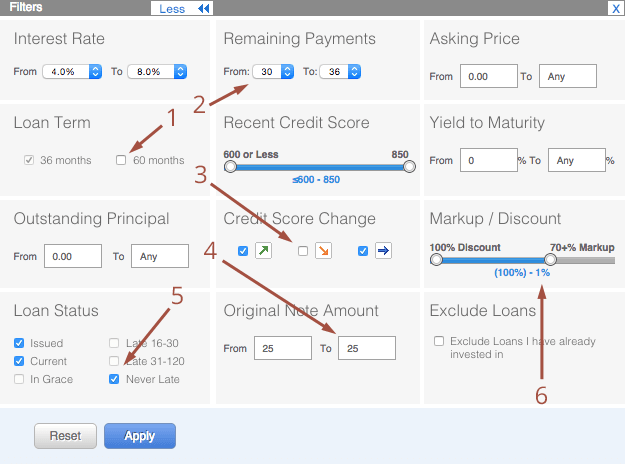
- Under Loan Term, uncheck the box for 60-months to only invest in 36-month (3 year) loans. 3-year loans have more consistent history, and represent a safer investment overall.
- Under Remaining Payments, set the minimum value to 30 (the box on the left). This means every loan will be somewhat brand new, each having made 6 or fewer payments (out of 36). Buying newer issued loans on Folio is generally a less risky approach since the sellers are less likely to be off-loading them for poor performance (wild swings in FICO, etc).
- Under Credit Score Change, uncheck the orange down arrow, leaving just the blue and green arrows. We want borrowers whose credit scores have not gone down, and the blue/green arrows mean their scores have stayed the same or improved since the loan was issued.
- Under Original Loan Amount, change the maximum box (on the right) to $25. This helps makes sure you choose $25 notes, keeping your account fully diversified.
- Make sure the Loan Status box of Never Late is still checked.
- Finally, under Markup/Discount, move the maximum (right slider) to 1%. Make sure it is “1%” without any parentheses. If it shows parentheses around it “(1%)”, this means a 1% discount and very few loans will show up. Setting the max markup to 1% ensures you do not overpay the seller for the note they are offering.
Click the blue Apply button. You’ll see the number of listed loans substantially decrease. For this article, the list shrank to just 2,700 loans. This is a much safer and more manageable list of loans to invest in.
Now we can choose the level of risk we want for our portfolio. As seen in the graphic below, A-grade loans have interest rates between 4% and 8%. To isolate these grades, we need to sort the list of available notes by interest rate, using the box in the upper left (though be aware these interest rates may change throughout the year).
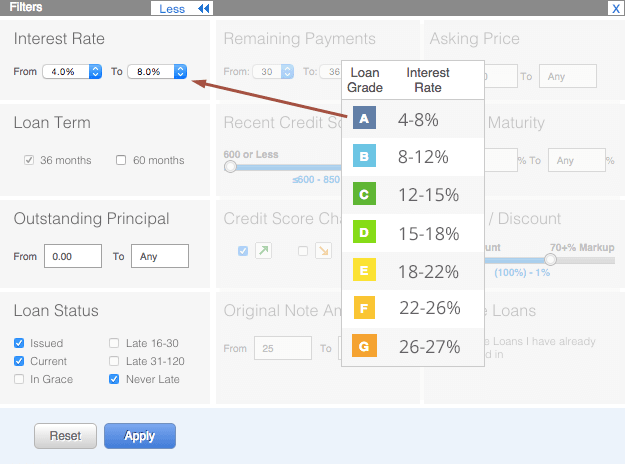
In this example, I’m going to spread my $5,000 lump sum across the safest three grades (200 notes across As, Bs, & Cs). This means placing a third of my investment in A-grade notes (67 notes), a third in B-grade notes (67 notes), and the last third in C-grade notes (66 notes). To do this, I have to align the minimum/maximum filter along each grade’s parameters.
- For A-grades, keep the minimum 4% and set the maximum to 8%
- For B-grades, set the minimum to 8% and the maximum 12%
- For C-grades, set the minimum to 12% and the maximum 15%
- Etc.
By isolating A-grade notes and hitting Apply, the secondary note pool shrinks from 180,000 loans to just 179, a much more manageable list.
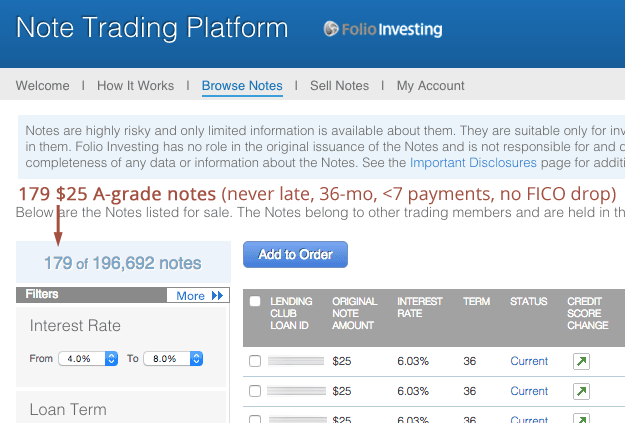
Click the Markup/Discount header to sort the list by Discount. This means the lowest-priced notes within that grade will move to the top of the list (IE: the notes that sellers have priced with the lowest overall premium). The Markup/Discount is correctly set when the arrow next to it is pointing up. Also, set the table to display 100 notes.
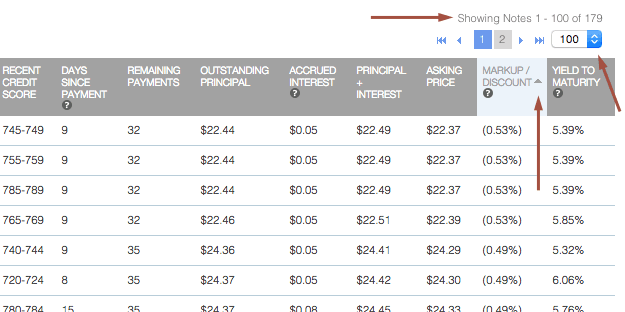
Now just invest your lump sum into a portion of these notes. For this example, I would invest in 67 of these A-grade notes. I would do this by clicking the boxes next to the top 67 notes on this screen, then clicking the Add to Order button. Once the notes have been added to the order, I would click the View Order button and be brought to this screen:
Above you see the Notes in your Order screen. By clicking on the Place Order button on the right, you have officially invested in notes on Lending Club’s Folio secondary market. Nice!
All that’s left to do is invest in the other loan grades (Bs and Cs in this example). To do this:
- Return to the Browse Notes area and set the six filters used above
- Adjust interest rates into the next grade (B-grades = min 8% max 12%)
- Filter the list and invest (67 B-grade notes – then repeat for C-grades)
- Any leftover cash should be invested as well
Congratulations, especially to those of you who live in “closed” states like Texas. You are officially a diversified peer to peer investor at Lending Club.
Have Just $2500? Stick with A-Grade Loans
This article covered the process for investing $5,000 across all the different loan grades. However, you can do this same process with less money — you just have to stick with A-grade loans. LendingMemo did a study last year that examined the diversification point based on loan grade, and found that investors need less diversification if they focus on less volatile grades. Read: Diversification and Loan Grades
As a result, you can opt to invest with $2,500, but you should stick to A-grade loans (interest rates below 8%) and make sure to minimize your risk through filters. Otherwise it is possible you won’t be fully diversified. Also note that your annual return will probably be in the lower 4-6% range, though your account will be much more resilient in something like a national economic downturn.
Can’t Find Enough Notes at Folio?
If the six filters above did not result in enough available notes to invest, you may want to broaden your criteria. You can widen the filters by:
- Decreasing the minimum number of payments from 30 (to 29, 28, etc).
- Increasing your note size. If you’re investing with $10K, you can still diversify in 200 notes by increasing your note size to $50. $20K investments could use $100 notes, etc ($20000 / 200 = $100). The important thing is to have 200 notes.
For low grades, you probably want to include 60-month notes.
If you have a greater risk tolerance, you may want to invest in low-grade notes (D, E, F, & G) – basically any note with an interest rate above 15%. But this will probably require broader filters than what we used above. For low grades, you may want to include 60-month notes (filtering for fewer payments – 55/54/etc) and increase the maximum markup/discount to 2%. The benefit of these lower grades is a much higher return, perhaps as high as 8% per year.
Be aware that broadening the filtering criteria from this article will result in a more risky investment. That said, I feel the difference is not so great as to stop most people from investing altogether. You simply need to be smart and conscious of what you’re doing.
Are the filters too generous? Too many returned notes? You could make your filters more strict, like increasing the minimum number of payments to 31, 32, etc.
Fight Cash Drag, Keep Available Cash Low
Once your lump sum is invested in 200+ notes, payments from these borrowers will begin flowing into your account and building up as available cash. This idle cash earns no interest, so you need to put it back to work in more notes. You can do this by logging back into your account a few times each month. Don’t worry, with time this process can take just a few minutes. Read more: Cash Drag and P2P Lending
This is one of the drawbacks of secondary market investing – you don’t get the automated investing option of the primary market. But most investors feel this extra bit of work is easily worth the great return. For those who take the time, you can set up the LendingRobot 3rd-party tool to auto-invest for you, though they charge a 0.45% fee to do this.
What is an expected return on Folio?
Most peer to peer lenders earn between a 5% and 9% return on their investment per year. However, buying notes on the secondary market often means paying a premium to sellers, which impacts the return. As a result, I would suggest most investors can expect a slightly lower overall return, perhaps between 4% and 8% per year for seasoned diversified portfolios, still a great return for the inherent stability that consumer credit offers us. Read: This Investment Has 20 Years of Positive Returns
4 More Strategies to Invest through Folio
This article covered how to mimic the primary market experience on the secondary market, picking up notes that are fresh and without much loan history. That said, there exists a plethora of additional investment strategies for Folio.
Option #1: Investing in notes with a positive payment history
Many investors prefer buying notes that have a long positive history. For example, you can click on the details of each note to see how the borrowers FICO credit score has changed month by month. Many investors prefer buying notes with 5-10 months of positive history, as they feel these notes have proven their borrowers to be responsible, and as such they are more trustworthy investments than fresh just-issued notes.
Option #2: Investing in notes that have gone late
Now we’re getting into cowboy country. Some investors have earned incredible returns by buying notes that have missed their most recent payment and become categorized as Late. These notes can often be bought at incredible discounts, quite often over 50%. Speculative investors can then buy these heavily discounted notes, and if they know how to pick them, earn incredible returns if these notes resume their payments. But this strategy has also lost money for investors, so take caution if you go in this direction.
Option #3: Actively buying and selling notes via an automated investing system
The most speculative and savvy investors use systems to auto-buy notes that meet specific criteria. For example, most sellers who are liquidating their accounts on Folio have no idea how to correctly price their notes, and when these steeply discounted notes hit the secondary market, automated systems race to be first in snapping up the notes, often going on to earn a soaring overall return. These systems can even auto-sell notes that are still Current but likely to default, such as having a steep drop in FICO.
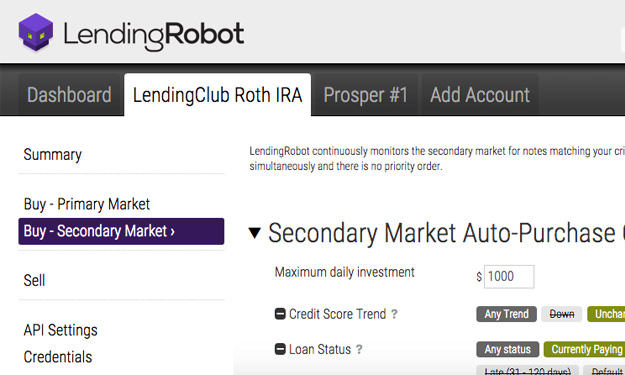
The most effective systems are custom built and off the radar, but those who don’t want the hassle of building their own rig can opt to use the 3rd-party tool LendingRobot which allows auto-buying and selling on Folio using fine-tuned preset criteria.
Option #4: Liquidating your account
The most helpful function of the secondary market is its ability to let lenders liquidate their investment. Big investors who are purchasing notes worth thousands of dollars each do not have such freedom, but small-dollar investors with $25, $50, or $100 notes who wish to exit this investment can often find willing buyers on Folio. Read: How to Liquidate and Close Your Account
Conclusion: Folio May be Wild, But It’s Worth It
In closing, know that the economy of the secondary market changes all the time. It is possible that this article will already be out of date six months from now — the filters may need to be reworked and the interface may have changed.
That said, I feel the Foliofn secondary market is a great option for people who want to begin peer to peer lending, but live in closed states. The investing process may be a bit complicated, but overall it allows millions of Americans a doorway through which they can access this wonderful asset class.
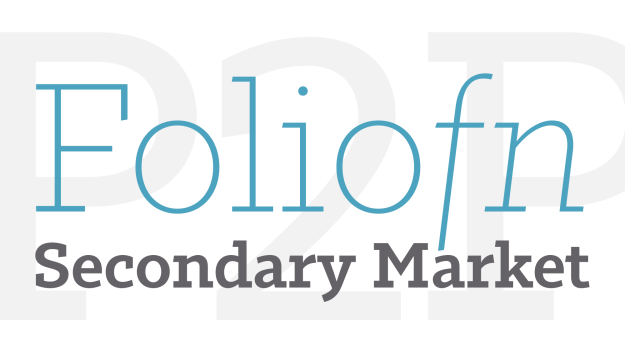
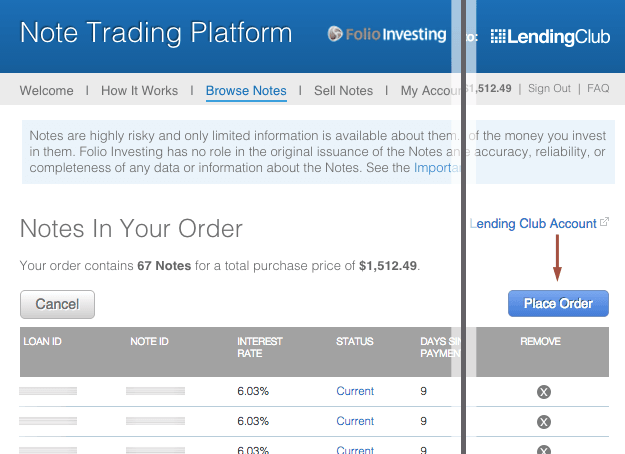
This is an excellent write-up on the trading platform! As I’ve mentioned before, I live in North Dakota, so I can only trade via the platform. I’m one of those that diversified my portfolio across most of the grades of loans. Currently, my dashboard is showing a return of slightly over 9%.
My picking strategy isn’t that far from what you outlined here, although I usually only buy a few at a time, so I take the time to go to each one individually and see what the usage was, employment history and a few other indicators and then decide whether it’s something to invest in or not. In the years I’ve been investing on Lending Club, I’ve only had 3-4 defaults, which I attribute partially to my picking strategy and to luck. :)
Glad to hear it Shane. As you probably know, Lending Club is unique since it provides a dashboard return for traded notes, something Prosper has yet to add.
9% is great. Did you choose notes that were somewhat new or that had a bit of payment history?
Actually, I don’t have any access to Prosper, since it’s not open in this state, so I didn’t know that. :) Good to know though!
My initial filter is pretty similar to the one that you lay out above. Biggest exceptions is that I allow the 60 month loans, and only look at ones that the credit score has increased since funding, never late, and show at least 4-5 months of payment history. More history is better, but at least 4-5 months.
Simon, this is excellent post, please share more in the future in regards second market, how you see potential growth with lending club entering the business loans and why additional P2P platform not using the secondary market , also do you know if foliofn have API access ?
Thank You
Hi Yaron. Lending Club may someday include business loans on Folio, but that is probably at least a year away, perhaps more. Prosper actually does include a secondary market, theirs is just simpler and smaller. At the moment, Folio does not allow API access, but this will likely change before the end of the year. Cheers!
Hey Simon
You mention you only buy notes with scores have stayed the same or improved since the loan was issued. What about buying a seasoned note (one that’s over 15 payments completed), but the credit score has gone down slightly. There’s a good buyers market for these on folio and I’m wondering if you’ve seen anyone test the performance?
Also you mention you filter out new notes that are over a 1% premium, but would you consider paying a higher premium for a seasoned note? I’ve seen a lot of data that suggests you can take 80% of the defaulting risk out of a loan that’s made it’s first 15 payments. So it would seem that paying a premium for these would be okay?
Let me know what you think, or if you’ve already written about it please refer me to that post.
Thanks!
Hi Jason. I know many investors who have used the strategies you’re talking about (seasoned notes with declining credit scores, etc.). I have not personally used them though. This article is written for beginner Folio investors. As they become more comfortable with the Folio economy, I don’t see why some of them shouldn’t consider additional strategies like you’re describing.
Cheers, Simon
I think this is a great article for getting into the secondary market. I don’t have access to the primary platform in my state, but I don’t mind. In my opinion, the main advantage to the primary LC platform is automated investing, which is a huge. The problem with it, though, is the lack of payment history. According to my credit report, the most important determinant to one’s credit score is payment history! Why shouldn’t I demand the same proof from LC borrowers?
Investing using Folio is tedious, but like you mentioned, it has plenty of perks. In regards to what Jaron said, I use a seasoned note strategy, but I don’t settle for paying premiums. I have found a wealth of never late notes that are selling at par or at a discount. All of them have a downward trending credit score, but as long as there aren’t any major drops or crazy changes within the last 6-8 months, I pull the trigger. I have even bought a few grace period notes, though I certainly wouldn’t consider that a beginner strategy! So far over the last 15 months, the average interest rate of my notes is 21%, and my XIRR ROI is 13.5%. That orange arrow or a few late payments (with an otherwise good payment record) shouldn’t scare you. Indeed, some of them are garbage, but often people will dump decent notes with great YTM! You just have to dig a little. I haven’t paid a premium on a note in a long time, and my returns are just fine by my standards.
Simon,
Thanks for your overview of the Folio investing system. I live in TX so I can only invest in Lending Club that way. I’ve invested for over a year now but I must say my experience has been ambivalent at best.
I did largely everything you had already suggested, buying new loans, not purchasing loans in trouble, and I even refused to pay any premium for them. Yet my return is around 3.8%, due mainly to a very high default rate. I may just be unlucky but I’m also not willing to spend hours combing through every loan to find out its purpose, debt-to-income ratio, etc.
I’ve thought about liquidating my account and getting out but I think would appreciate it more if I had access to the main retail site. Any word on if TX is going to open up any time soon?
Thanks for all your comments.
Hi Brian. 3.8% is indeed low, though I do think its possible you were active on Folio before Lending Club “cleaned it up” over the past year. Essentially they added a lot of guard-rails (default: “never late”) to increase buyer returns. Since then, there are much better protection for buyers against bad loans, etc, so most investors should have an experience similar to the primary market by doing what I suggest in this article.
The latest on Texas is probably here: https://www.lendingmemo.com/lending-club-and-prosper-states/
In short, it may still be a while, perhaps even 3-5 years or more until every state opens up, though I believe many will open in the next 18 months. It all depends on how hard your security regulators drag their heels.
Simon,
Just an update – I just received a new email from Lending Club today telling me that Texas is now (fully) open to investors. I imagine you might have gathered this from sources elsewhere but just thought I’d pass it along. I’m looking forward to testing the “native” experience.
Regards,
Brian
Any news on Alabama opening up to the primary market anytime soon? Thanks for a great article and the step by step instructions. I am tempted to start but a little concerned about how tedious the process will be once I am up and running.
Thanks,
Shawn
I live in Ohio. Is there no investing opportunity through either Lending Club or Prosper? This is what it appears like in my reading and understanding within your website.
Sherron
Hi Sherron. Correct: OH is not open to Lending Club or Prosper. At this time, Folio may be your best option. Simon
I know that in order to invest in Lending Club one needs to meet certain income requirements. Is that also the case with trading on the Secondary market of lending club through Foliofn? Or can anybody trade on the Lending club secondary market, regardless of their income?
Thanks for such a great site
1) I have 3,000 current loans so a 3% markup creates many negative and positive yield to maturity results & going through hundreds of them is very time consuming. I tried to sort by number of months left, only selecting the top 60, and starting with a markup of maybe 3%, but even that has wildly different yield to maturity results so question is: is there any other way to separate the loans that can be sold with a 3% markup from those that will only work with say a 1% markup instead of going through the whole list and changing every number?
2) I was successful at placing 200 of my most recent loans for sale already at a 3% markup. Now when I try to sell all my current loans, are the ones already approved for sale included again in the list or are they set aside and not included because they are already for sale?
Hmm. Invest only in new notes , 30-36 remaining payments? Unless youre buying at an incredible discount this is a horrible stategy. Its really the reverse of how to use the trading platform. But… if that leaves less competition for the good notes and saves me the time to looking for them… Good for me.
I reinvest on the trading platform a couple times a week. After I apply the filters available, I’m typically left with ~400 notes. Of those, I use a couple additional self imposed filters not available. It’s time consuming but well worth it. I’m then left with maybe 5-10 total. The strategy thus far has been incredible though. If the trend continues as I see it, I expect 14% returns
This strategy was fruitful back when this article was first published, but it may not work anymore. Thanks for your comment.
I’ve just started with the Folio Trading Platform and I don’t understand the Yield to Maturity value that they report. I thought this was the expected ROI but the number is always way higher than the ROI that I calculate. I assume I’m either calculating something wrong or just don’t understand what the Yield to Maturity value represents. Perhaps someone can explain it? Just for example I’m looking at a Note now with a Yield to Maturity of 7.86%. The asking price is $9.26 and remaining payments is $9.74. By my reckoning (assuming the remaining balance isn’t paid off/down early) the ROI is simply the difference between what the borrower paid and what I invested which would be ($9.74 -$9.26)/($9.26) * 100 = 5.18%. That’s a far cry from 7.86%. Where am I going wrong?